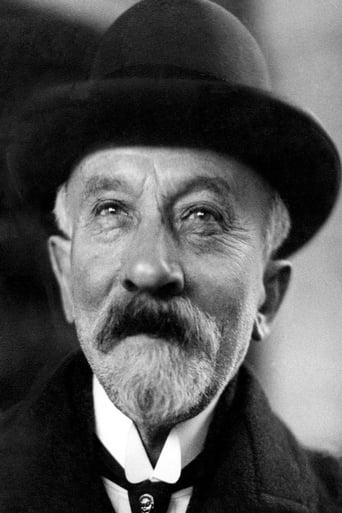SpuffyWeb
Sadly Over-hyped
ThedevilChoose
When a movie has you begging for it to end not even half way through it's pure crap. We've all seen this movie and this characters millions of times, nothing new in it. Don't waste your time.
Kien Navarro
Exactly the movie you think it is, but not the movie you want it to be.
Erica Derrick
By the time the dramatic fireworks start popping off, each one feels earned.
Ben Davis
There was an adaptation of Cinderella all the way back in 1899. Who knew? It's pretty good. So good in fact that I'm going to go ahead and predict that this is going to be a 100x better than the live action version Disney's releasing. Anyway, George Méliès manages to tell the story without cutting anything major out. It has the fairy godmother transforming the mice into knights (I think they were knights) and the pumpkin into a carriage, it has the ball, it has the clock striking midnight, it as the Prince looking for Cinderella, and it has the happy ending we've come to expect from fairy tale adaptations. All that was accomplished way back in 1899. If that isn't amazing, then I don't know what is. The only part I didn't like was the part I didn't understand. It was the part directly after the clock strikes midnight. It had Cinderella in her house with all these old guys dancing around with clocks. I don't know what that was all about, but it doesn't really affect my overall opinion of this short.
Horst in Translation (filmreviews@web.de)
because if you watch this short film without knowing at all what the Cinderella tale is about, you'd quickly be lost and that's never a good thing for a film. It needs to tell us a story that we understand and while Méliès manages most of the time to do so, this one proved too big of a challenger. Visually, however, it's as nice as always with him, especially the hand-colored fairy all dressed in red. The little bearded man with the clocks implying time runs out was a bit of an oddity. I'm not exactly certain if he appears in the tale or if it was just one of Méliès' funnily odd inventions. Good addition in any case. Most of the aspects of the story are depicted convincingly if you know it beforehand. One thing though that i really wasn't too fond of was the huge dance near the end. Should have ended after the weeding IMO. Still a decent work and you could see Méliès and film industry in 1906 slowly opened up to longer movies. This was a step ahead.
MartinHafer
My score of 10 is relative to other productions during this very early era in film as well as director Georges Méliès' other films. If you were to compare it to later silent films, then CENDRILLON will come up very, very short due to its very archaic style. And this type of comparison just wouldn't be fair, as non-stationary cameras, composition and detailed scripts were well in the future. But, for 1899, this is amazing because it introduces dissolves to go from one scene to another, a plot telling an actual story, as well as actual sets--things not used much around 1900. Most of the films circa 1900 were dull and short--only a minute or two long and featured people doing horribly mundane things--like feeding a baby or watering the lawn (seriously).Now this story, while amazing for 1899, is not without many problems. The first portion that set the context for the story seems to either be missing or Méliès just assumed the audience understood it and skipped it. Also, while the first moments of the film are hand-colored, this disappears very quickly--perhaps it comes from piecing two or more copies together to make this film. And additionally, at times the people had no idea what to do, so they did some weird things--like have lots and lots of clocks and elves (why?!?!) as well as a somewhat impromptu dance number at the end. Rough? Yes, but still compared to what else was out there, this was the best sort of film available...period. For film historians, this and the rest of Méliès' films are a must.By the way, to see just how far films had progressed, try also watching the 1914 version starring Mary Pickford. It stands up much better today and is a truly magnificent film even almost a hundred years later.
boblipton
This is the earliest surviving of Melies super-productions -- the best known one, of course, is his Trip to the Moon -- and the story begins right where Melies can strut his stuff with the appearance of the Fairy Godmother. Some of the earliest sequences are beautifully hand-tinted.Of greater technical interest is Melies' experimentation with film grammar: he uses a fade to get from Cinderella's garret to the ball. And of course, there are lots of his combinations of stage and film magic, as mice are transformed into footmen, pumpkins appear out of nowhere and the fairy godmother leaves by being lowered into the stage. Tremendous fun and far more watchable than any other version through the 1920s.This is one of the many previously lost or infrequently seen Melies pictures that have been made available by Serge Bromberg, David Shepherd and a myriad of other hands in the newly issued DVD set GEORGES MELIES: FIRST WIZARD OF CINEMA. Required viewing for anyone interested in the history of movies ..... and a lot of fun.

